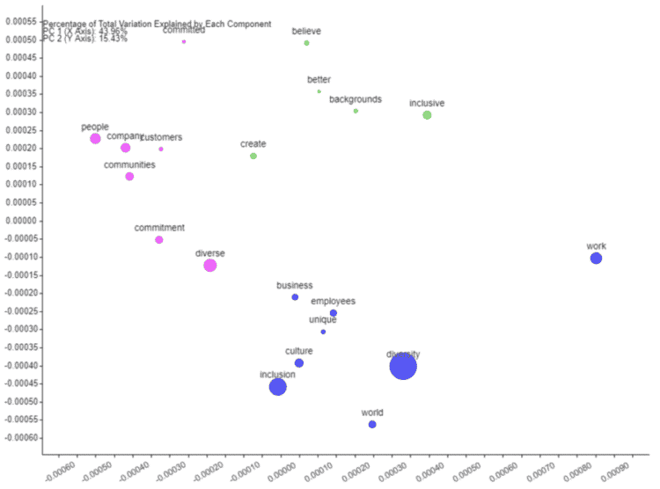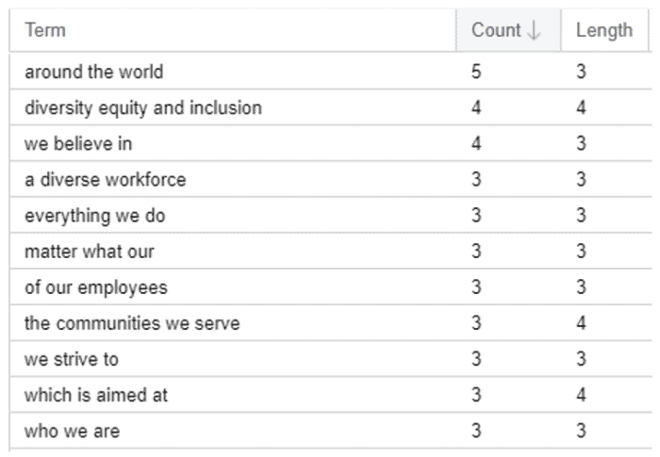The DE&I statement is a must-have for any diversity equity and inclusion program. In our quest to see what makes an ideal DE&I statement, we analyzed 50 DE&I statements from organizations in different verticals. We share our findings in this post.
The Nature of the DE&I Statement
The DE&I (Diversity, Equity and Inclusion) statement is a declaration of an organization’s commitment to furthering the three values named in the parentheses. It’s a statement that is usually found in the company’s HR policy and it is put out for the public to see. There is no right or wrong way to draft the DE&I statement. After all, it’s not a token. What’s in the statement has no real bearing on the actual policies and actions of the organization when it comes to ensuring the three aforementioned values. The statement is becoming popular amongst corporations in multiple different industry verticals. What was once restricted to educational institutions is now becoming common in the corporate world. But there is still a long way to go when it comes to developing DE&I programs. In a survey of 800 HR professionals, three-quarters of them reported that their companies do not consider DE&I in leadership development. It is treated less as a business function and more as a compliance requirement. Thus, when looking at a field that is yet to be fully integrated with the business structure and strategy, the DE&I statement may be wrongly perceived as a temporary placeholder. It is not. It is a living statement that both communicates the company’s stand and informs the vision as it pertains to diversity, equity and inclusion. It is open to be rewritten in light of new goals or findings.Getting Clarity on the DEI Statement
If the DEI statement is truly a piece of the overall DE&I strategy and not a showpiece, there needs to be some serious thought given to drafting such a statement. It’s best to self-reflect and come to terms with where the company stands today. Subsequently, it helps to imagine the DE&I vision for the company, regarding where it wants to be with the program in the future. But all these things still need to be communicated via the DE&I statement. It may be many folks’ first introduction to understanding your company’s attitude and dealings with DE&I. Even after knowing where your company stands on DE&I, and what its vision is, there is a style and cadence to the statements that are becoming recognizable to all. As there is no real guidance on how to craft the perfect DE&I statement, we thought we would turn our gaze outwards, and look at some of the most widely recognized companies and their DE&I statements. One can seek inspiration from others, and indeed there are articles out there covering DE&I examples from organizations. But rather than simply copying off one statement, it is better to gain a holistic understanding by analyzing multiple statements. We analyzed 50 DE&I statements for this article to bring you some learnings. But first, let’s take a look at the sample and the methodology.The Sample
For our sample, we picked out DE&I statements from large corporations in multiple consumer-facing industries. By consumer-facing, we are referring to secondary or tertiary industries, which sell products and services consumers can use. Raw materials (like the energy industry) or products meant for governments (like the defense industry) were thus ruled out. We looked at consumer-facing industries because the end customer is an important stakeholder that gets prioritized more in secondary and tertiary industries. We also wanted to restrict our sample for greater internal validity. For a future study, we might consider looking at the primary industry exclusively. We chose the top 5 revenue generators in 2020 in each industry vertical. We picked the biggest corporations in terms of revenue because we wanted to examine the best work. Best, not necessarily in terms of quality, because mid-tier and small and medium businesses can produce great DE&I statements too. But in terms of using all available resources to craft the statement. We knew that all of these companies would have invested considerable time and effort into writing their DE&I statements. In-house HR leaders, hired consultants and HR agencies would have been a part of the process to come up with statements. Out of the top 5 revenue generators in each vertical, there were some organizations outside North America for which a DE&I statement was not found. In those instances, we simply skipped to the next option in the list until we had met our quota of top 5 revenue generators in that vertical. This isn’t surprising, however, as DE&I has been more of a North American push.The List of Organizations in our Study

Selecting the DE&I Statements
As far as selecting the statements go, we had to use some discernment as there is no official rulebook as to where to find such a statement or how long such a statement should be (though we do get into the length of it in the analysis section). For each company, we picked the statement or the paragraph that had at least two of the three words of diversity, equity and inclusion. If any statement had all three words, it got the nod over other examples. The DEI statement did not have a common home for all companies. In some cases, it was found in the featured Google Snippet when we searched for the DEI statement of the said organization. Where a featured snippet did not appear, we had to click on the results to see where such a statement could be found. It was usually found on a dedicated page. If not, it was on the people, careers or jobs page. We had to be careful to not pick anything other than the statement. Sometimes we stumbled across pages with DEI reports. These were not statements. Similarly, there were bullet points, or separated boxes in the website design that spoke more deeply about each of the three issues of diversity, equity and inclusion. Again, such cases were a false match. What we were looking for was a block of text, that could either just include a tagline, or more than a tagline, such as a subheader and some following sentences, that summarized the company’s stance, attitude and vision on DEI.Methodology
Having selected our list of companies and their statements, it was time to analyze. We used the open-source web-based app called Voyant Tools to perform descriptive text analysis that included topic clustering, and word & phrase frequency distributions. For topic clustering, we used Principal Component Analysis. It’s a technique used to reduce the dimensions of the data which explains the maximum variability in the data. Topics are then plotted across those dimensions. The clusters of topics help us to understand the different themes in the text. We fed all 50 DE&I statements into the tool. Together they formed the body, or the corpus, of the text that was to be analyzed. As a reminder, the purpose of this study was exploratory in nature. We do not have a hypothesis to test and hence are not prescribing any one best way to write a DE&I statement. Rather, by looking at the text of existing DE&I statements for which no resources were spared, we hoped to gain some insight into their anatomy.Findings
The principal component analysis reduced the text to two dimensions or components. The two components jointly explained almost 60% of the variability of the data. There was a sharp drop off in the percentage of variability of the third component, so it made sense to use two components for better interpretability. Voyant Tools churned out a scatterplot of topics, showing how they differed along the lines of the two components. The coloured bubbles represent different clusters of topics. The size of the bubble represents the frequency of that topic, with a bigger bubble implying greater frequency.Principal Component Analysis Scatterplot

Description of the Three Clusters
As our sample was text and not actual variables from a quantitative survey, we had to put our thinking caps on and infer what each colored cluster of topics represented. 1. In Blue - Inner Workings of The Company These topics signify the current state of the company. They talk about what makes the company “unique” which informs its DE&I policies. They speak to the company’s “culture” regarding DE&I, and its stance on “Diversity” and "Inclusion”. This topic takes a very internal position, focusing on “employees” and how DE&I policies seep into all aspects of “work”. 2. In Pink - Unified Understanding These topics emphasize the togetherness of all involved. It takes a more external position, consisting of “people”, “customers” and “communities”. Rather than just stating what the company thinks, it assures “commitment” to DE&I causes considering all parties. It is definitely more people-centric than company-centric. 3. In Green - Promise to Improve These topics take a vision-oriented approach. They signify the company’s intentions to “create” a “better” system that is more “inclusive” and considerate of all “backgrounds”. The idea here is to not explain what the company does for whom, but what it can do better in the future.
Word Frequency
The corpus (body of the text consisting of all 50 DE&I statements) had 3,982 words in total and 1049 unique words. Out of those unique words, here are the top 20 most frequently used words. Their respective counts are displayed as well.
Learnings
1. Diversity and inclusion separate them from the rest of the pack. Equity does not feature in the top 20. For those curious, it features 8 times. This difference in frequency shows the larger mind space diversity and inclusion still holds over equity. 2. Just like the “employees” interact with the “customers”, the company interacts with its “community” at the smallest scale, and the “world” at the largest scale. All 5 words are on the list. 3. It shows the value of all types of relationships, both internal and external, and how important the DE&I statement is in communicating that message. The words “believe”, “better” and “committed” are also featured heavily. It signals a humble tone. There is an acknowledgment that things can always be done better.Phrase Frequency
Similar to how we ranked the most commonly occurring words, we did the same for phrases. It gives us further context in understanding the DE&I statement. We considered all phrases which appeared at least thrice in the corpus and which consisted of at least three words.



